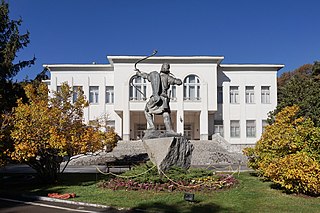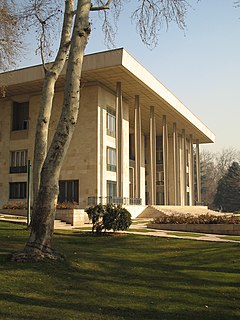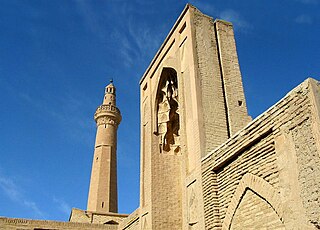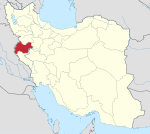
A tughra is a calligraphic monogram, seal or signature of a sultan that was affixed to all official documents and correspondence. It was also carved on his seal and stamped on the coins minted during his reign. Very elaborate decorated versions were created for important documents that were also works of art in the tradition of Ottoman illumination, such as the example of Suleiman the Magnificent in the gallery below.

Tehran Province is one of the 31 provinces of Iran. It covers an area of 18,814 square kilometres (7,264 sq mi) and is located to the north of the central plateau of Iran.

The Golestan Palace is the former royal Qajar complex in Iran's capital city, Tehran.

Kermanshah Province is one of the 31 provinces of Iran. The province was known from 1969 to 1986 as Kermanshahan and from 1986 to 1995 as Bakhtaran. According to a 2014 segmentation by the Ministry of Interior it is center of Region 4, with the region's central secretariat located at the province's capital city, Kermanshah. A majority of people in Kermanshah Province are Shia, and there are Sunni and Yarsani minority groups.

Qazvin Province is one of the 31 provinces of Iran. It is in the north-west of the country, and its center is the city of Qazvin. The province was created in 1993 out of part of Tehran Province. The counties of Qazvin Province are Qazvin County, Takestan County, Abyek County, Buin Zahra County, Mobarakeh County, Alborz County & Avaj County. The largest cities are Qazvin, Takestan, Abyek, Alvand, Iran, Bidestan, Mobarakeh, Mohammadiyeh & Eqbaliyeh.

The Sa'dabad Complex is a 300 hectare complex built by the Qajar and Pahlavi monarchs, located in Shemiran, Greater Tehran, Iran. Today, the official residence of the President of Iran is located adjacent to the complex.

The Niavaran Palace Complex is a historical palace complex situated in Shemiran, Iran. It consists of several palace buildings and monuments dating back to the Qajar and Pahlavi eras.

Kermanshah, also known as Kermāshān, is the capital of Kermanshah Province, located 525 kilometres from Tehran in the western part of Iran. According to the 2016 census, its population is 946,681. A majority of Kirmaşan's population speaks Southern Kurdish, and the city is the largest Kurdish-speaking city in Iran. Kirmaşan has a moderate and mountainous climate. Most of the inhabitants of Kermashan are Shia Muslims, but there are also Sunni Muslims and followers of Yarsanism.

A tekyeh is a place where Shiite Muslims gather to mourn muharram. Such places are particularly found in Iran. They are usually traditionally designed with observable elements of Persian architecture. Tehran is said to have had up to 50 tekyeh in the Qajar era. There are tekyeh in almost every Iranian city. They look like mosques but are used during the month of Muharram.

The arts of Iran are one of the richest art heritages in world history and encompasses many traditional disciplines including architecture, painting, literature, music, weaving, pottery, calligraphy, metalworking and stonemasonry. There is also a very vibrant Iranian modern and contemporary art scene, as well as cinema and photography. For a history of Persian visual art up to the early 20th century, see Persian art, and also Iranian architecture.

Malek National Museum and Library is a museum and national library in Tehran, Iran. Malek National Library and Museum Institution (MNLMI) is the first private museum of Iran and one of the six large libraries holding exquisite manuscripts. The MNLMI collection is a rich trove of the best manuscripts and Iranian historical artworks. The Institution is located in the historical precinct of “Bagh-e Melli” that is considered the cultural-historical center of Tehran. The MNLM visitors include a large number of university students and researchers, as well as tourists who enjoy its library and museum facilities. It is one of the biggest libraries of precious manuscripts in Iran, built by Hadji Hussein Agha Malek, at the time the richest man in Iran. He built it in a traditional Persian architecture style. One of the biggest contributors is Esat Malek Malek, Hadji Hussein Agha Malek's eldest daughter, who contributed to the museum's development.

Nain is a city and capital of Nain County, Isfahan Province, Iran. At the 2011 census, its population was 25,379 in 7,730 families.

Qajar art refers to the art, architecture, and art-forms of the Qajar dynasty of the late Persian Empire, which lasted from 1781 to 1925 in Iran (Persia).

Ta'zieh or Ta'zïye or Ta'zīya or Tazīa or Ta'ziyeh means comfort, condolence or expression of grief. It comes from roots aza which means mourning.

The Amir Nezām House, or The Qajar Museum of Tabriz, is a historical building in the Sheshghelan district, one of the oldest quarters of the city of Tabriz, Iran. The base of the edifice covers an area of 1200 square metres. This monument which since 2006 houses a museum dedicated to the Qajar dynasty (1781-1925), was built in the period of the Crown Prince Abbas Mirza (1789-1833). It was renovated by Hasan-Ali Khan, Hasan Ali Khan Garroosy, in his position as the Major-domo of Azarbaijan, and used as his residency. In the subsequent periods, the house was employed as the official residence of the provincial governors of Azarbaijan. Because of persistent neglect over a long period of time, this building had come to be in such a bad state of disrepair that for a time it was seriously considered to demolish it and build a school in its place. Between 1993-2006 it has been subject of an extensive renovation process and since the completion of this undertaking it has been granted the National Heritage status.

Tekyeh Dowlat was a Royal Theater in Tehran, Iran. It was the most famous of all the ta'zieh performance spaces, for the Mourning of Muharram. It has a capacity for more than 4,000 people. Built in 1868 by Naser al-Din Shah Qajar south-east of the Golestan Palace on the site of the Síyáh-Chál, the Royal Theater's sumptuous magnificence surpassed that of Europe's greatest opera houses in the opinion of many Western visitors. It is comparable to Verona Arena, Samuel Greene Wheeler Benjamin told at his first visit.

Persian art or Iranian art has one of the richest art heritages in world history and has been strong in many media including architecture, painting, weaving, pottery, calligraphy, metalworking and sculpture. At different times, influences from the art of neighbouring civilizations have been very important, and latterly Persian art gave and received major influences as part of the wider styles of Islamic art. This article covers the art of Persia up to 1925, and the end of the Qajar dynasty; for later art see Iranian modern and contemporary art, and for traditional crafts see arts of Iran. Rock art in Iran is its most ancient surviving art. Iranian architecture is covered at that article.

Tekyeh Moaven al-molk is a Tekyeh and historical place located in Kermanshah city of Iran. It was built during Qajar era as a Shia mourning site. On 1 December 1975 Tekyeh Moaven al-molk was recognized as National monument of Iran. It is well known for its exclusive tiling, picturing Islamic era Ghazi (warrior), Battle of Karbala and Iranian kings such as Achaemenid kings and Persepolis. It has three main parts: Hussainiya, Zaeynabiya and Abbasiya. Museum of Anthropology of Kermanshah, and Clothes and Jewelry Museum of Kermanshah are located in Abbasiya.

The Emad o dolah Mosque is related to the Qajar dynasty and is located in Kermanshah.

Hiwa Pashaei or Hiva Pashaei is a Kurdish painter, photographer, calligrapher, graphist, curator and publisher from Iran, living in the United States. He is active in the fields of painting, graphic design, research and education of visual arts. Pashaei is known for his spearhead role in pixel art in Iran and Kurdistan. Pashaei is also renowned because of his innovative use of Kurdish culture themes, specially culture of Kermanshah region Kurds, creating figurative works with the subject of Kurdish women, and presenting these themes in the form of modern and post modern art. He is manager of Rouge Art Gallery and Founder of Jowan Visual Art School in Tehran, and also CEO & Founder of Art & Culture Center of California "ACCC" in Los Angeles. Pashaei has held several individual and group exhibitions in Iran and other countries like Iraq, Japan, Italy, France and United States.



























